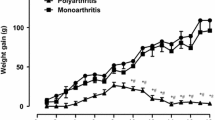Abstract
Electron microscopy of differentially centrifuged synovial fluid from patients with differing types of arthritis revealed a few membranes bearing complement lesions. It was shown that this is due to activation of the alternate pathway of complement by leukocytic enzymes. It is not clear where the site of action is in inflammatory exudates; it may be on internal membranes of the cells, as no detectable cytotoxic effect could be found using Rb86 as a marker for specific release. In addition, lysosomal enzymes have the net effect of inhibiting the hemolysis of indicator cells caused by activation of the alternate pathway by inulin.
Similar content being viewed by others
References
Ruddy, S., andK.F. Austen. 1973. Activation of the complement system in rheumatoid arthritis.Fed. Proc. 32:134.
Fostiropoulos, G., K.F. Austen, andK.J. Bloch. 1965. Total hemolytic complement (CH50) and 2nd component of complement (C'2 hu) activity in serum and synovial fluid.Arthritis Rheum. 8:219.
Zvaifler, N.J. 1969. Breakdown products of C'3 in human synovial fluids.J. Clin. Invest. 48:1532.
Rodman, W.W., R.C. Williams, P.J. Bilka, andH.J. Müller-Eberhard. 1967. Immunofluorescent localisation of the third and fourth components of complement in synovial tissue from patients with rheumatoid arthritis.J. Lab. Clin. Med. 69:141.
Goldstein, I.M., andG. Weissmann. 1974. Generation of C5-derived lysosomal enzyme-releasing activity (C5a) by lysates of leukocyte lysosomes.J. Immunol. 113:1583.
Talalay, P., W.H. Fishman, andC. Huggins. 1946. Chromogenic substrates II. Phenophthalein glucuronic acid as substrate for the assay of glucuronidase activity.J. Biol. Chem. 166:757.
Taffs, L.F. Personal communication.
Sirchia, G., andJ.V. Dacie. 1967. Immune lysis of AET-treated normal red cells (PNH-like cells).Nature 215:747.
Goldstein, B.D. 1974. Production of paroxysmal nocturnal haemoglobinuria-like red cells by reducing and oxidising agents.Br. J. Haematol. 26:49.
Götze, O., andH.J. Müller-Eberhard. 1971. Paroxysmal nocturnal hemoglobinuria: Hemolysis initiated by the C3 activator system.N. Engl. J. Med. 286:180.
Platts-Mills, T.A.E., andK. Ishizaka. 1974. Activation of the alternate pathway of human complement by rabbit cells.J. Immunol. 113:348.
Pryjma, J., J.H. Humphrey, andG.G.B. Klaus 1974. C3 activation and T-independent B cell stimulation.Nature 252:505.
Humphrey, J.H., andR.R. Dourmashkin. 1969. The lesions in cell membranes caused by complement.In Advances in Immunology, Vol. 11, F.J. Dixon and H.G. Kunkel, editors. Academic Press, New York, 75.
Author information
Authors and Affiliations
Rights and permissions
About this article
Cite this article
Dourmashkin, R.R., Patterson, S. Complement lesions in cell membranes from joint effusions of various types of arthritis. Inflammation 1, 155–166 (1976). https://doi.org/10.1007/BF00917526
Issue Date:
DOI: https://doi.org/10.1007/BF00917526




